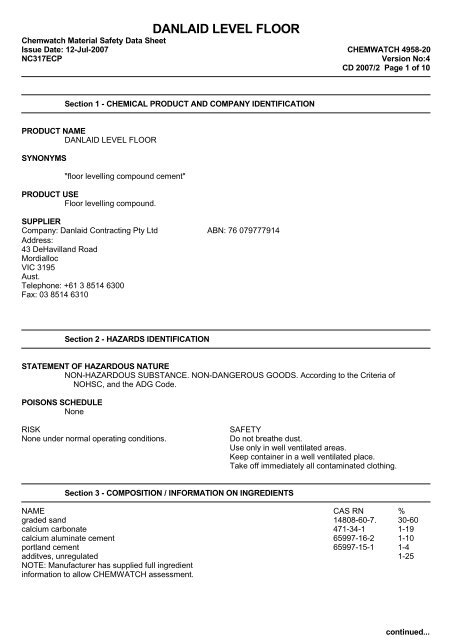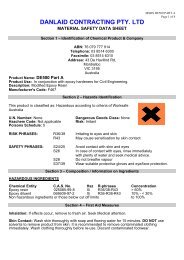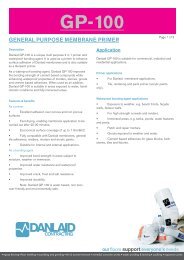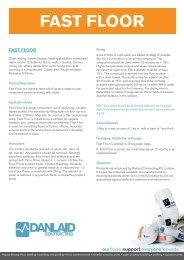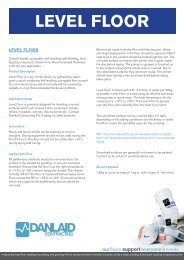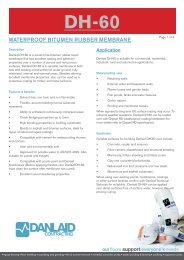DANLAID LEVEL FLOOR - Danlaid Contracting
DANLAID LEVEL FLOOR - Danlaid Contracting
DANLAID LEVEL FLOOR - Danlaid Contracting
You also want an ePaper? Increase the reach of your titles
YUMPU automatically turns print PDFs into web optimized ePapers that Google loves.
<strong>DANLAID</strong> <strong>LEVEL</strong> <strong>FLOOR</strong><br />
Chemwatch Material Safety Data Sheet<br />
Issue Date: 12-Jul-2007 CHEMWATCH 4958-20<br />
NC317ECP<br />
Version No:4<br />
CD 2007/2 Page 1 of 10<br />
Section 1 - CHEMICAL PRODUCT AND COMPANY IDENTIFICATION<br />
PRODUCT NAME<br />
<strong>DANLAID</strong> <strong>LEVEL</strong> <strong>FLOOR</strong><br />
SYNONYMS<br />
"floor levelling compound cement"<br />
PRODUCT USE<br />
Floor levelling compound.<br />
SUPPLIER<br />
Company: <strong>Danlaid</strong> <strong>Contracting</strong> Pty Ltd ABN: 76 079777914<br />
Address:<br />
43 DeHavilland Road<br />
Mordialloc<br />
VIC 3195<br />
Aust.<br />
Telephone: +61 3 8514 6300<br />
Fax: 03 8514 6310<br />
Section 2 - HAZARDS IDENTIFICATION<br />
STATEMENT OF HAZARDOUS NATURE<br />
NON-HAZARDOUS SUBSTANCE. NON-DANGEROUS GOODS. According to the Criteria of<br />
NOHSC, and the ADG Code.<br />
POISONS SCHEDULE<br />
None<br />
RISK<br />
None under normal operating conditions.<br />
SAFETY<br />
Do not breathe dust.<br />
Use only in well ventilated areas.<br />
Keep container in a well ventilated place.<br />
Take off immediately all contaminated clothing.<br />
Section 3 - COMPOSITION / INFORMATION ON INGREDIENTS<br />
NAME CAS RN %<br />
graded sand 14808-60-7. 30-60<br />
calcium carbonate 471-34-1 1-19<br />
calcium aluminate cement 65997-16-2 1-10<br />
portland cement 65997-15-1 1-4<br />
additves, unregulated 1-25<br />
NOTE: Manufacturer has supplied full ingredient<br />
information to allow CHEMWATCH assessment.<br />
continued...
<strong>DANLAID</strong> <strong>LEVEL</strong> <strong>FLOOR</strong><br />
Chemwatch Material Safety Data Sheet<br />
Issue Date: 12-Jul-2007 CHEMWATCH 4958-20<br />
NC317ECP<br />
Version No:4<br />
CD 2007/2 Page 2 of 10<br />
Section 4 - FIRST AID MEASURES<br />
SWALLOWED<br />
- If swallowed do NOT induce vomiting.<br />
- If vomiting occurs, lean patient forward or place on left side (head-down position, if<br />
possible) to maintain open airway and prevent aspiration.<br />
- Observe the patient carefully.<br />
- Never give liquid to a person showing signs of being sleepy or with reduced awareness;<br />
i.e. becoming unconscious.<br />
- Give water to rinse out mouth, then provide liquid slowly and as much as casualty can<br />
comfortably drink.<br />
- Seek medical advice.<br />
EYE<br />
SKIN<br />
INHALED<br />
If this product comes in contact with the eyes:<br />
- Wash out immediately with fresh running water.<br />
- Ensure complete irrigation of the eye by keeping eyelids apart and away from eye and<br />
moving the eyelids by occasionally lifting the upper and lower lids.<br />
- If pain persists or recurs seek medical attention.<br />
- Removal of contact lenses after an eye injury should only be undertaken by skilled<br />
personnel.<br />
Brush off dust.<br />
If skin or hair contact occurs:<br />
- Flush skin and hair with running water (and soap if available).<br />
- Seek medical attention in event of irritation.<br />
- If dust is inhaled, remove from contaminated area.<br />
- Encourage patient to blow nose to ensure clear breathing passages.<br />
- Ask patient to rinse mouth with water but to not drink water.<br />
- Seek immediate medical attention.<br />
NOTES TO PHYSICIAN<br />
Treat symptomatically.<br />
Section 5 - FIRE FIGHTING MEASURES<br />
EXTINGUISHING MEDIA<br />
- There is no restriction on the type of extinguisher which may be used.<br />
- Use extinguishing media suitable for surrounding area.<br />
FIRE FIGHTING<br />
- Alert Fire Brigade and tell them location and nature of hazard.<br />
- Wear breathing apparatus plus protective gloves for fire only.<br />
- Prevent, by any means available, spillage from entering drains or water courses.<br />
- Use fire fighting procedures suitable for surrounding area.<br />
- DO NOT approach containers suspected to be hot.<br />
- Cool fire exposed containers with water spray from a protected location.<br />
- If safe to do so, remove containers from path of fire.<br />
- Equipment should be thoroughly decontaminated after use.<br />
FIRE/EXPLOSION HAZARD<br />
- Non combustible.<br />
continued...
<strong>DANLAID</strong> <strong>LEVEL</strong> <strong>FLOOR</strong><br />
Chemwatch Material Safety Data Sheet<br />
Issue Date: 12-Jul-2007 CHEMWATCH 4958-20<br />
NC317ECP<br />
Version No:4<br />
CD 2007/2 Page 3 of 10<br />
Section 5 - FIRE FIGHTING MEASURES<br />
- Not considered a significant fire risk, however containers may burn.<br />
FIRE INCOMPATIBILITY<br />
None known.<br />
HAZCHEM: None<br />
Personal Protective Equipment<br />
Breathing apparatus.<br />
Gas tight chemical resistant suit.<br />
Limit exposure duration to 1 BA set 30 mins.<br />
Section 6 - ACCIDENTAL RELEASE MEASURES<br />
EMERGENCY PROCEDURES<br />
MINOR SPILLS<br />
- Clean up all spills immediately.<br />
- Avoid contact with skin and eyes.<br />
- Control personal contact by using protective equipment.<br />
- Use dry clean up procedures and avoid generating dust.<br />
- Place in a suitable labelled container for waste disposal.<br />
MAJOR SPILLS<br />
Moderate hazard.<br />
- CAUTION: Advise personnel in area.<br />
- Alert Emergency Services and tell them location and nature of hazard.<br />
- Control personal contact by wearing protective clothing.<br />
- Prevent, by any means available, spillage from entering drains or water courses.<br />
- Recover product wherever possible.<br />
- IF DRY: Use dry clean up procedures and avoid generating dust. Collect residues and<br />
place in sealed plastic bags or other containers for disposal. IF WET: Vacuum/shovel up<br />
and place in labelled containers for disposal.<br />
- ALWAYS: Wash area down with large amounts of water and prevent runoff into drains.<br />
- If contamination of drains or waterways occurs, advise Emergency Services.<br />
EMERGENCY RESPONSE PLANNING GUIDELINES (ERPG)<br />
The maximum airborne concentration below which it is believed that nearly all individuals could be exposed<br />
for up to one hour WITHOUT experiencing or developing<br />
life-threatening health effects is:<br />
graded sand 50 mg/m³<br />
calcium carbonate 15 mg/m³<br />
irreversible or other serious effects or symptoms which could impair an individual's ability to take<br />
protective action is:<br />
graded sand 0.25 mg/m³<br />
calcium carbonate 15 mg/m³<br />
other than mild, transient adverse effects without perceiving a clearly defined odour is:<br />
graded sand 0.15 mg/m³<br />
calcium carbonate 15 mg/m³<br />
The threshold concentration below which most people will experience no appreciable risk of health effects:<br />
graded sand 0.15 mg/m³<br />
continued...
<strong>DANLAID</strong> <strong>LEVEL</strong> <strong>FLOOR</strong><br />
Chemwatch Material Safety Data Sheet<br />
Issue Date: 12-Jul-2007 CHEMWATCH 4958-20<br />
NC317ECP<br />
Version No:4<br />
CD 2007/2 Page 4 of 10<br />
Section 6 - ACCIDENTAL RELEASE MEASURES<br />
calcium carbonate<br />
15 mg/m³<br />
American Industrial Hygiene Association (AIHA)<br />
Ingredients considered according to the following cutoffs<br />
Very Toxic (T+) >= 0.1% Toxic (T) >= 3.0%<br />
R50 >= 0.25% Corrosive (C) >= 5.0%<br />
R51 >= 2.5%<br />
else >= 10%<br />
where percentage is percentage of ingredient found in the mixture<br />
Personal Protective Equipment advice is contained in Section 8 of the MSDS.<br />
Section 7 - HANDLING AND STORAGE<br />
PROCEDURE FOR HANDLING<br />
- Limit all unnecessary personal contact.<br />
- Wear protective clothing when risk of exposure occurs.<br />
- Use in a well-ventilated area.<br />
- Avoid contact with incompatible materials.<br />
- When handling, DO NOT eat, drink or smoke.<br />
- Keep containers securely sealed when not in use.<br />
- Avoid physical damage to containers.<br />
- Always wash hands with soap and water after handling.<br />
- Work clothes should be laundered separately.<br />
- Use good occupational work practice.<br />
- Observe manufacturer's storing and handling recommendations.<br />
- Atmosphere should be regularly checked against established exposure standards to ensure<br />
safe working conditions are maintained.<br />
SUITABLE CONTAINER<br />
- Polyethylene or polypropylene container.<br />
- Check all containers are clearly labelled and free from leaks.<br />
STORAGE INCOMPATIBILITY<br />
None known.<br />
STORAGE REQUIREMENTS<br />
- Keep dry.<br />
- Store under cover.<br />
- Protect containers against physical damage.<br />
- Observe manufacturer's storing and handling recommendations.<br />
Section 8 - EXPOSURE CONTROLS / PERSONAL PROTECTION<br />
EXPOSURE CONTROLS<br />
Source Material TWA ppm TWA mg/m³ STEL ppm STEL mg/m³Peak ppm Peak mg/m³ TWA F/CC<br />
_________ _________ _____ _____ _____ _____ _____ _____ _____<br />
Australia calcium 10<br />
Exposure<br />
Standards<br />
carbonate<br />
(Calcium<br />
carbonate<br />
(a))<br />
Australia calcium 10<br />
Exposure aluminate<br />
continued...
<strong>DANLAID</strong> <strong>LEVEL</strong> <strong>FLOOR</strong><br />
Chemwatch Material Safety Data Sheet<br />
Issue Date: 12-Jul-2007 CHEMWATCH 4958-20<br />
NC317ECP<br />
Version No:4<br />
CD 2007/2 Page 5 of 10<br />
Section 8 - EXPOSURE CONTROLS / PERSONAL PROTECTION<br />
Source Material TWA ppm TWA mg/m³ STEL ppm STEL mg/m³Peak ppm Peak mg/m³ TWA F/CC<br />
_________ _________ _____ _____ _____ _____ _____ _____ _____<br />
Standards cement<br />
(Inspirabl<br />
e dust<br />
(Not<br />
specified)<br />
)<br />
Australia portland 10<br />
Exposure<br />
Standards<br />
cement<br />
(Portland<br />
cement<br />
(a))<br />
EMERGENCY EXPOSURE LIMITS<br />
Material Revised IDLH Value (mg/m3) Revised IDLH Value (ppm)<br />
graded sand 50<br />
portland cement 5, 000<br />
MATERIAL DATA<br />
Not available. Refer to individual constituents.<br />
INGREDIENT DATA<br />
CALCIUM CARBONATE:<br />
PORTLAND CEMENT:<br />
Sensory irritants are chemicals that produce temporary and undesirable side-effects on<br />
the eyes, nose or throat. Historically occupational exposure standards for these<br />
irritants have been based on observation of workers' responses to various airborne<br />
concentrations. Present day expectations require that nearly every individual should be<br />
protected against even minor sensory irritation and exposure standards are established<br />
using uncertainty factors or safety factors of 5 to 10 or more. On occasion animal no<br />
-observable-effect-levels (NOEL) are used to determine these limits where human results<br />
are unavailable. An additional approach, typically used by the TLV committee (USA) in<br />
determining respiratory standards for this group of chemicals, has been to assign ceiling<br />
values (TLV C) to rapidly acting irritants and to assign short-term exposure limits (TLV<br />
STELs) when the weight of evidence from irritation, bioaccumulation and other endpoints<br />
combine to warrant such a limit. In contrast the MAK Commission (Germany) uses a five<br />
-category system based on intensive odour, local irritation, and elimination half-life.<br />
However this system is being replaced to be consistent with the European Union (EU)<br />
Scientific Committee for Occupational Exposure Limits (SCOEL); this is more closely<br />
allied to that of the USA.<br />
OSHA (USA) concluded that exposure to sensory irritants can:<br />
- cause inflammation<br />
- cause increased susceptibility to other irritants and infectious agents<br />
- lead to permanent injury or dysfunction<br />
- permit greater absorption of hazardous substances and<br />
- acclimate the worker to the irritant warning properties of these substances thus<br />
increasing the risk of overexposure.<br />
GRADED SAND:<br />
NOTE: This product contains negligible amount of respirable dust.<br />
CALCIUM CARBONATE:<br />
The TLV-TWA is thought to be protective against the significant risk of<br />
physical irritation associated with exposure.<br />
continued...
<strong>DANLAID</strong> <strong>LEVEL</strong> <strong>FLOOR</strong><br />
Chemwatch Material Safety Data Sheet<br />
Issue Date: 12-Jul-2007 CHEMWATCH 4958-20<br />
NC317ECP<br />
Version No:4<br />
CD 2007/2 Page 6 of 10<br />
Section 8 - EXPOSURE CONTROLS / PERSONAL PROTECTION<br />
PORTLAND CEMENT:<br />
Portland cement is considered to be a nuisance dust that does not cause<br />
fibrosis and has little potential to induce adverse effects on the lung.<br />
PERSONAL PROTECTION<br />
EYE<br />
- Safety glasses with side shields.<br />
- Chemical goggles.<br />
- Contact lenses may pose a special hazard; soft contact lenses may absorb and<br />
concentrate irritants. A written policy document, describing the wearing of lens or<br />
restrictions on use, should be created for each workplace or task. This should include a<br />
review of lens absorption and adsorption for the class of chemicals in use and an account<br />
of injury experience. Medical and first-aid personnel should be trained in their removal<br />
and suitable equipment should be readily available. In the event of chemical exposure,<br />
begin eye irrigation immediately and remove contact lens as soon as practicable. Lens<br />
should be removed at the first signs of eye redness or irritation - lens should be<br />
removed in a clean environment only after workers have washed hands thoroughly. [CDC<br />
NIOSH Current Intelligence Bulletin 59].<br />
HANDS/FEET<br />
Wear chemical protective gloves, eg. PVC.<br />
Wear safety footwear or safety gumboots, eg. Rubber.<br />
NOTE: The material may produce skin sensitisation in predisposed individuals. Care must<br />
be taken, when removing gloves and other protective equipment, to avoid all possible skin<br />
contact.<br />
OTHER<br />
- Overalls.<br />
- P.V.C. apron.<br />
- Barrier cream.<br />
- Skin cleansing cream.<br />
- Eye wash unit.<br />
RESPIRATOR<br />
Protection Factor Half- Face Respirator Full- Face Respirator Powered Air Respirator<br />
10 x ES P1 Air- line* - - PAPR- P1 -<br />
50 x ES Air- line** P2 PAPR- P2<br />
100 x ES - P3 -<br />
Air- line* -<br />
100+ x ES - Air- line** PAPR- P3<br />
* - Negative pressure demand ** - Continuous flow.<br />
The local concentration of material, quantity and conditions of use determine the type of<br />
personal protective equipment required.<br />
For further information consult site specific<br />
CHEMWATCH data (if available), or your<br />
Occupational Health and Safety Advisor.<br />
ENGINEERING CONTROLS<br />
General exhaust is adequate under normal operating conditions. Local exhaust ventilation<br />
may be required in specific circumstances. If risk of overexposure exists, wear approved<br />
respirator. Correct fit is essential to obtain adequate protection. Provide adequate<br />
ventilation in warehouse or closed storage areas.<br />
continued...
<strong>DANLAID</strong> <strong>LEVEL</strong> <strong>FLOOR</strong><br />
Chemwatch Material Safety Data Sheet<br />
Issue Date: 12-Jul-2007 CHEMWATCH 4958-20<br />
NC317ECP<br />
Version No:4<br />
CD 2007/2 Page 7 of 10<br />
Section 9 - PHYSICAL AND CHEMICAL PROPERTIES<br />
APPEARANCE<br />
Grey powder; partly soluble in water.<br />
PHYSICAL PROPERTIES<br />
Molecular Weight: Not Applicable<br />
Melting Range (°C): Not Available<br />
Solubility in water (g/L): Partly Miscible<br />
pH (1% solution): Not Applicable<br />
Volatile Component (%vol): Not Applicable<br />
Relative Vapour Density (air=1): Not Applicable<br />
Lower Explosive Limit (%): Not Applicable<br />
Autoignition Temp (°C): Not Available<br />
State: Divided Solid<br />
Boiling Range (°C): Not Ap plicable<br />
Specific Gravity (water= 1): Not Available<br />
pH (as supplied): Not Applicable<br />
Vapour Pressure (kPa): Not Applicable<br />
Evaporation Rate: Not Applicable<br />
Flash Point (°C): Not Applicable<br />
Upper Explosive Limit (%): Not Applicable<br />
Decomposition Temp ( °C): Not Available<br />
Viscosity: Not Applicable<br />
Section 10 - CHEMICAL STABILITY AND REACTIVITY INFORMATION<br />
CONDITIONS CONTRIBUTING TO INSTABILITY<br />
- Presence of incompatible materials.<br />
- Product is considered stable.<br />
- Hazardous polymerisation will not occur.<br />
Section 11 - TOXICOLOGICAL INFORMATION<br />
POTENTIAL HEALTH EFFECTS<br />
ACUTE HEALTH EFFECTS<br />
SWALLOWED<br />
The material has NOT been classified by EC Directives or other classification systems as<br />
"harmful by ingestion". This is because of the lack of corroborating animal or human<br />
evidence. The material may still be damaging to the health of the individual, following<br />
ingestion, especially where pre-existing organ (eg. liver, kidney) damage is evident.<br />
Present definitions of harmful or toxic substances are generally based on doses producing<br />
mortality rather than those producing morbidity (disease, ill-health). Gastrointestinal<br />
tract discomfort may produce nausea and vomiting. In an occupational setting however,<br />
ingestion of insignificant quantities is not thought to be cause for concern.<br />
EYE<br />
The material may produce moderate eye irritation leading to inflammation. Repeated or<br />
prolonged exposure to irritants may produce conjunctivitis.<br />
SKIN<br />
Entry into the blood-stream, through, for example, cuts, abrasions or lesions, may<br />
produce systemic injury with harmful effects. Examine the skin prior to the use of the<br />
material and ensure that any external damage is suitably protected.<br />
Solution of material in moisture on the skin, or perspiration, may increase irritant<br />
effects.<br />
Handling wet cement can cause dermatitis. Cement when wet is quite alkaline and this<br />
alkali action on the skin contributes strongly to cement contact dermatitis since it may<br />
cause drying and defatting of the skin which is followed by hardening, cracking, lesions<br />
developing, possible infections of lesions and penetration by soluble salts.<br />
continued...
<strong>DANLAID</strong> <strong>LEVEL</strong> <strong>FLOOR</strong><br />
Chemwatch Material Safety Data Sheet<br />
Issue Date: 12-Jul-2007 CHEMWATCH 4958-20<br />
NC317ECP<br />
Version No:4<br />
CD 2007/2 Page 8 of 10<br />
Section 11 - TOXICOLOGICAL INFORMATION<br />
The material may cause skin irritation after prolonged or repeated exposure and may<br />
produce a contact dermatitis (nonallergic). This form of dermatitis is often<br />
characterised by skin redness (erythema) and swelling epidermis. Histologically there may<br />
be intercellular oedema of the spongy layer (spongiosis) and intracellular oedema of the<br />
epidermis.<br />
INHALED<br />
Inhalation of dusts, generated by the material during the course of normal handling, may<br />
be damaging to the health of the individual.<br />
Inhalation of dust may aggravate a pre-existing respiratory condition such as asthma,<br />
bronchitis, emphysema.<br />
CHRONIC HEALTH EFFECTS<br />
Long term exposure to high dust concentrations may cause changes in lung function i.e.<br />
pneumoconiosis; caused by particles less than 0.5 micron penetrating and remaining in the<br />
lung. Prime symptom is breathlessness; lung shadows show on X-ray.<br />
There is limited evidence that, skin contact with this product is more likely to cause a<br />
sensitisation reaction in some persons compared to the general population.<br />
As with any chemical product, contact with unprotected bare skin; inhalation of vapour,<br />
mist or dust in work place atmosphere; or ingestion in any form, should be avoided by<br />
observing good occupational work practice.<br />
TOXICITY AND IRRITATION<br />
Not available. Refer to individual constituents.<br />
GRADED SAND:<br />
unless otherwise specified data extracted from RTECS - Register of Toxic Effects of Chemical Substances.<br />
No data of toxicological significance identified in literature search.<br />
CALCIUM CARBONATE:<br />
unless otherwise specified data extracted from RTECS - Register of Toxic Effects of Chemical Substances.<br />
TOXICITY<br />
IRRITATION<br />
Oral (Rat) LD50: 6450 mg/kg<br />
Skin (rabbit): 500 mg/24h- Moderate<br />
Eye (rabbit): 0.75 mg/24h - SEVERE<br />
The material may produce severe irritation to the eye causing pronounced inflammation.<br />
Repeated or prolonged exposure to irritants may produce conjunctivitis.<br />
The material may cause skin irritation after prolonged or repeated exposure and may<br />
produce on contact skin redness, swelling, the production of vesicles, scaling and<br />
thickening of the skin.<br />
No evidence of carcinogenic properties.<br />
No evidence of mutagenic or<br />
teratogenic effects.<br />
CALCIUM ALUMINATE CEMENT:<br />
No data of toxicological significance identified in literature search.<br />
PORTLAND CEMENT:<br />
unless otherwise specified data extracted from RTECS - Register of Toxic Effects of Chemical Substances.<br />
Asthma-like symptoms may continue for months or even years after exposure to the material<br />
ceases. This may be due to a non-allergenic condition known as reactive airways<br />
dysfunction syndrome (RADS) which can occur following exposure to high levels of highly<br />
irritating compound. Key criteria for the diagnosis of RADS include the absence of<br />
preceding respiratory disease, in a non-atopic individual, with abrupt onset of<br />
persistent asthma-like symptoms within minutes to hours of a documented exposure to the<br />
irritant. A reversible airflow pattern, on spirometry, with the presence of moderate to<br />
severe bronchial hyperreactivity on methacholine challenge testing and the lack of<br />
minimal lymphocytic inflammation, without eosinophilia, have also been included in the<br />
criteria for diagnosis of RADS. RADS (or asthma) following an irritating inhalation is an<br />
infrequent disorder with rates related to the concentration of and duration of exposure<br />
to the irritating substance. Industrial bronchitis, on the other hand, is a disorder that<br />
continued...
<strong>DANLAID</strong> <strong>LEVEL</strong> <strong>FLOOR</strong><br />
Chemwatch Material Safety Data Sheet<br />
Issue Date: 12-Jul-2007 CHEMWATCH 4958-20<br />
NC317ECP<br />
Version No:4<br />
CD 2007/2 Page 9 of 10<br />
Section 11 - TOXICOLOGICAL INFORMATION<br />
occurs as result of exposure due to high concentrations of irritating substance (often<br />
particulate in nature) and is completely reversible after exposure ceases. The disorder<br />
is characterised by dyspnea, cough and mucus production.<br />
MATERIAL CARCINOGEN REPROTOXIN SENSITISER SKIN<br />
________________________ ____________________ ________________ ________________ _____________<br />
graded sand<br />
IARC:1<br />
CARCINOGEN<br />
IARC: International Agency for Research on Cancer (IARC) Carcinogens: graded sand<br />
Category: 1<br />
Section 12 - ECOLOGICAL INFORMATION<br />
DO NOT discharge into sewer or waterways.<br />
Refer to data for ingredients, which follows:<br />
PORTLAND CEMENT:<br />
DO NOT discharge into sewer or waterways.<br />
Section 13 - DISPOSAL CONSIDERATIONS<br />
- Recycle wherever possible.<br />
- Consult manufacturer for recycling options or consult local or regional waste<br />
management authority for disposal if no suitable treatment or disposal facility can be<br />
identified.<br />
- Dispose of by: Burial in a licenced land-fill or Incineration in a licenced apparatus<br />
(after admixture with suitable combustible material)<br />
- Decontaminate empty containers. Observe all label safeguards until containers are<br />
cleaned and destroyed.<br />
Section 14 - TRANSPORTATION INFORMATION<br />
HAZCHEM: None<br />
NOT REGULATED FOR TRANSPORT OF DANGEROUS GOODS:UN, IATA,<br />
IMDG<br />
Section 15 - REGULATORY INFORMATION<br />
POISONS SCHEDULE: None<br />
REGULATIONS<br />
graded sand (CAS: 14808-60-7) is found on the following regulatory lists;<br />
Australia - New South Wales Hazardous Substances Prohibited for Specific Uses<br />
Australia - New South Wales Hazardous Substances Requiring Health Surveillance<br />
Australia - South Australia Hazardous Substances Requiring Health Surveillance<br />
Australia - Tasmania Hazardous Substances Prohibited for Specified Uses<br />
Australia - Tasmania Hazardous Substances Requiring Health Surveillance<br />
Australia - Western Australia Hazardous Substances Requiring Health Surveillance<br />
Australia Exposure Standards<br />
Australia Hazardous Substances Requiring Health Surveillance<br />
continued...
<strong>DANLAID</strong> <strong>LEVEL</strong> <strong>FLOOR</strong><br />
Chemwatch Material Safety Data Sheet<br />
Issue Date: 12-Jul-2007 CHEMWATCH 4958-20<br />
NC317ECP<br />
Version No:4<br />
CD 2007/2 Page 10 of 10<br />
Section 15 - REGULATORY INFORMATION<br />
Australia High Volume Industrial Chemical List (HVICL)<br />
Australia Inventory of Chemical Substances (AICS)<br />
Australia Occupational Health and Safety (Commonwealth Employment) (National Standards)<br />
Regulations 1994 - Hazardous Substances Requiring Health Surveillance<br />
International Agency for Research on Cancer (IARC) Carcinogens<br />
OECD Representative List of High Production Volume (HPV) Chemicals<br />
calcium carbonate (CAS: 471-34-1) is found on the following regulatory lists;<br />
Australia High Volume Industrial Chemical List (HVICL)<br />
Australia Inventory of Chemical Substances (AICS)<br />
Australia Therapeutic Goods Administration (TGA) Substances that may be used as active<br />
ingredients in Listed medicines<br />
CODEX General Standard for Food Additives (GSFA) - Additives Permitted for Use in Food<br />
in General, Unless Otherwise Specified, in Accordance with GMP<br />
International Council of Chemical Associations (ICCA) - High Production Volume List<br />
OECD Representative List of High Production Volume (HPV) Chemicals<br />
calcium carbonate (CAS: 1317-65-3) is found on the following regulatory lists;<br />
Australia Exposure Standards<br />
Australia Inventory of Chemical Substances (AICS)<br />
OECD Representative List of High Production Volume (HPV) Chemicals<br />
calcium aluminate cement (CAS: 65997-16-2) is found on the following regulatory lists;<br />
Australia Exposure Standards<br />
Australia High Volume Industrial Chemical List (HVICL)<br />
Australia Inventory of Chemical Substances (AICS)<br />
calcium aluminate cement (CAS: 12042-68-1) is found on the following regulatory lists;<br />
Australia Exposure Standards<br />
Australia High Volume Industrial Chemical List (HVICL)<br />
Australia Inventory of Chemical Substances (AICS)<br />
portland cement (CAS: 65997-15-1) is found on the following regulatory lists;<br />
Australia Exposure Standards<br />
Australia High Volume Industrial Chemical List (HVICL)<br />
Australia Inventory of Chemical Substances (AICS)<br />
OECD Representative List of High Production Volume (HPV) Chemicals<br />
No data available for calcium carbonate as CAS: 13397-26-7, CAS: 15634-14-7.<br />
Section 16 - OTHER INFORMATION<br />
INGREDIENTS WITH MULTIPLE CAS NUMBERS<br />
Ingredient Name<br />
CAS<br />
calcium carbonate 471- 34- 1, 13397- 26- 7, 15634- 14- 7, 1317-<br />
65- 3<br />
calcium aluminate cement 65997- 16- 2, 12042- 68- 1<br />
Classification of the preparation and its individual components has drawn on official and<br />
authoritative sources as well as independent review by the Chemwatch Classification<br />
committee using available literature references.<br />
This document is copyright. Apart from any fair dealing for the purposes of private study, research, review or<br />
criticism, as permitted under the Copyright Act, no part may be reproduced by any process without written permission<br />
from CHEMWATCH. TEL (+61 3) 9572 4700.<br />
Issue Date: 12-Jul-2007<br />
Print Date: 12-Jul-2007


